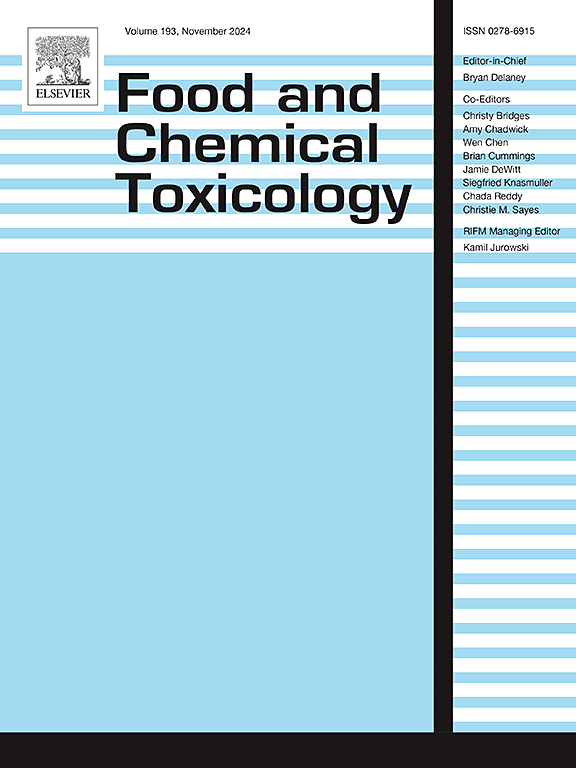Epigallocatechin-3-gallate as an effective inhibitor of vascular endothelial dysfunction induced by endothelial-localized myeloperoxidase
IF 3.9
3区 医学
Q2 FOOD SCIENCE & TECHNOLOGY
引用次数: 0
Abstract
In inflammatory vasculature, the leukocyte-released myeloperoxidase (MPO) is internalized by endothelial cells and this enzyme promotes endothelial dysfunction by catalytically producing strong oxidant, hypochlorous acid (HOCl). Herein, we developed epigallocatechin-3-gallate (EGCG, the main polyphenolic flavonoid found in green tea) as a novel endothelial-targeted MPO inhibitor. It was shown that culture of MPO and EGCG with vascular endothelial cells could result in their transport into the sub-endothelial space. EGCG significantly suppressed the consumption of enzyme's substrate H2O2 and generation of HOCl catalyzed by endothelial-transcytosed MPO. The binding of EGCG to the hydrophobic domain near the distal active heme cavity of enzyme was proposed by molecular docking and was suggested for the inhibitive effect of flavonoid on MPO activity. In vivo, EGCG attenuated lipopolysaccharide (LPS)-induced endothelial dysfunction in mouse aortas, while it inhibited the infiltration of active MPO into vascular walls. Furthermore, MPO-deficient mice were resistant to the protective effects of EGCG on LPS-induced vascular dysfunction, as compared to wild-type mice. These studies showed that EGCG effectively inhibited local oxidative reactions and endothelial dysfunction catalyzed by vascular-bound MPO. EGCG represents a versatile class of natural antioxidant drugs applicable to target endothelial-transcytosed MPO in inflammatory vasculature.

表没食子儿茶素-3-没食子酸酯作为内皮定位髓过氧化物酶诱导的血管内皮功能障碍的有效抑制剂。
在炎性血管中,白细胞释放的髓过氧化物酶(MPO)被内皮细胞内化,该酶通过催化产生强氧化剂次氯酸(HOCl)促进内皮功能障碍。在这里,我们开发了表没食子儿茶素-3-没食子酸酯(EGCG,绿茶中发现的主要多酚类黄酮)作为一种新的内皮靶向MPO抑制剂。结果表明,MPO和EGCG与血管内皮细胞一起培养可导致其转运到亚内皮空间。EGCG显著抑制酶底物H2O2的消耗和内皮转胞MPO催化的HOCl的生成。通过分子对接提出EGCG与酶远端活性血红素腔附近的疏水结构域结合,并提出了黄酮类化合物对MPO活性的抑制作用。在体内,EGCG可以减轻脂多糖(LPS)诱导的小鼠主动脉内皮功能障碍,同时抑制活性MPO向血管壁的浸润。此外,与野生型小鼠相比,mpo缺陷小鼠对EGCG对lps诱导的血管功能障碍的保护作用具有抗性。这些研究表明,EGCG能有效抑制血管结合MPO催化的局部氧化反应和内皮功能障碍。EGCG代表了一种多用途的天然抗氧化药物,适用于炎症血管中内皮转细胞化的MPO。
本文章由计算机程序翻译,如有差异,请以英文原文为准。
求助全文
约1分钟内获得全文
求助全文
来源期刊

Food and Chemical Toxicology
工程技术-毒理学
CiteScore
10.90
自引率
4.70%
发文量
651
审稿时长
31 days
期刊介绍:
Food and Chemical Toxicology (FCT), an internationally renowned journal, that publishes original research articles and reviews on toxic effects, in animals and humans, of natural or synthetic chemicals occurring in the human environment with particular emphasis on food, drugs, and chemicals, including agricultural and industrial safety, and consumer product safety. Areas such as safety evaluation of novel foods and ingredients, biotechnologically-derived products, and nanomaterials are included in the scope of the journal. FCT also encourages submission of papers on inter-relationships between nutrition and toxicology and on in vitro techniques, particularly those fostering the 3 Rs.
The principal aim of the journal is to publish high impact, scholarly work and to serve as a multidisciplinary forum for research in toxicology. Papers submitted will be judged on the basis of scientific originality and contribution to the field, quality and subject matter. Studies should address at least one of the following:
-Adverse physiological/biochemical, or pathological changes induced by specific defined substances
-New techniques for assessing potential toxicity, including molecular biology
-Mechanisms underlying toxic phenomena
-Toxicological examinations of specific chemicals or consumer products, both those showing adverse effects and those demonstrating safety, that meet current standards of scientific acceptability.
Authors must clearly and briefly identify what novel toxic effect (s) or toxic mechanism (s) of the chemical are being reported and what their significance is in the abstract. Furthermore, sufficient doses should be included in order to provide information on NOAEL/LOAEL values.
 求助内容:
求助内容: 应助结果提醒方式:
应助结果提醒方式:


